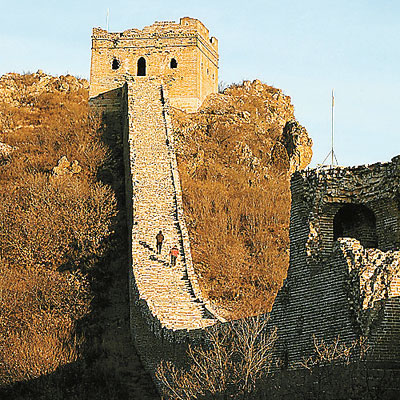
For many, a visit to China is not complete without setting foot on the Great Wall. Due to its rich history and mythical status as the longest man-made structure, the Great Wall has become an almost required sight-seeing stop for all travelers to China.
With 4 million visitors a year, the irony is not lost in knowing that a Chinese fortification built for the purpose of protecting dynasties from tribal raids now specifically caters to invading hordes of foreigners through tours and kitschy merchandise, such as "I climbed the Great Wall" T-shirts.
In China's haste to accommodate millions of visitors during the Beijing Olympics, great efforts are being made towards physical restoration, but frequently a sense of history becomes lost in the renovation process. For anyone intent on experiencing a section of the Great Wall that retains a more antiquated air, the Great Wall at Simatai remains one of the best options for spectacular views while preserving a sense of historical context.
Located in the north of Miyun County,130 kilometers northeast of Beijing, Simatai has been designated as a World Cultural Heritage site by UNESCO and has been described by some as the “best of the Great Wall.” Originally built during the Northern Qi Dynasty (550-577) and then rebuilt during the Hongwu years of the Ming Dynasty (1368-1644) by Qi Jiguang, this section of Simatai is known for its inimitable, unique design as one of the few areas to retain the original features of the Ming Dynasty Great Wall.
The Simatai Great Wall starts from Wangjing Building in the east and ends at Houchuankou in the west. Stretching for 5.7 kilometers and containing 35 watchtowers (including the tower in the water which has been damaged), it is one section of the Great Wall with concentrated watchtowers. The distance between the nearest two towers is shorter than 20 meters.
The Simatai Great Wall has an imposing manner and strategically important situation. The whole section is carefully designed with various types of walls and watchtowers. Most of them are well-preserved, which shows the wisdom of laborers in ancient times, and have high military, artistic and architectural values.
Despite having endured more than 400 years of weathering, the Simatai Great Wall maintains a large quantity of bricks engraved with words and exquisite embossment, displaying its perfect construction technology that allows it to preserve the historical information to the maximum degree.
The Simatai Great Wall is separated by the Miyun Reservoir into eastern and western parts. The western part is a comparatively moderate hike with 20 well-preserved watchtowers, while the eastern section with 16 watchtowers is much steeper with rocky terrain that makes hiking a more demanding experience.
The eastern part is built on sharp mountain ridges, rising from 295 meters to 986 meters within only 2.7 kilometers, so it looks like a huge dragon flying out from the lake towards the clouds. One may look at the Great Wall from the air, and appreciate various types of watchtowers, obstacle walls, marvelous pools, and huge tortoise stones.
The smooth western part of the Simatai Great Wall is quite attractive, with its original buttressed walls, parapets, doors and windows, tops of buildings, holes for shooting, drains, water faucets and so on.
Hiking at Simatai can be challenging, but the energy put into traversing lofty peaks and precipitous terrain — sometimes precariously close to cliff edges — is rewarded with unparalleled vistas.
Nowadays there is a cable car, with round trip tickets costing 50 yuan (US$7) and one-way tickets at 30 yuan, which serves as a drop-off point about 40 minutes on foot from the Simatai Great Wall. It could be a useful alternative if you have a sprained ankle or want to spend time wandering about the Great Wall at a more leisurely pace.
In addition, there is a toboggan ride from the Simatai Great Wall to the cable car, costing 30 yuan. This element of the Simatai experience is unnecessary and a waste of money, since anyone who wants to reach the cable car can walk directly to it via a flight of stairs.
For now, Simatai remains breathtaking and tranquil. By distancing yourself from the area dotted with cable cars meandering down to the car park, and turning your gaze towards the hills calmly undulating far into the distance, it is possible to imagine history springing back to life. The image of solitary soldiers manning watchtowers over the years is suddenly more tangible than it has ever been. It is within this serene environment that you can begin to see how these echoes of history have settled into the Chinese countryside, and Simatai begins to feel like your own piece of Great Wall history.
(Agencies via Shenzhen Daily May 27, 2008)